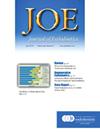Peripheral Lysosomal Positioning in Inflamed Odontoblasts Facilitates Mineralization
IF 3.5
2区 医学
Q1 DENTISTRY, ORAL SURGERY & MEDICINE
引用次数: 0
Abstract
Introduction
Odontoblasts, terminally differentiated dentin-producing cells, critically rely on lysosomal functions for intracellular recycling and renewal. Beyond their traditional degradative role, lysosomes actively orchestrate cellular responses to external stimuli through precise and rapid intracellular trafficking and positioning. This study aimed to explore the influence of lysosomal positioning on odontoblast mineralization and the underlying mechanisms implicated in carious inflammation.
Methods
Human dental pulp stem cells were induced to differentiate into human odontoblast-like cells (hOBLCs). hOBLCs were treated with various doses of LPS (0.1, 1, 5 μg/mL) to mimic carious inflammation. Lysosomal positioning was examined by immunofluorescence staining of lysosomal associated membrane protein 1 in healthy and carious human teeth, LPS-treated hOBLCs, mouse lower incisors at postnatal day 2.5, and mineralization medium cultured human dental pulp stem cells. Lysosomal positioning was manipulated by knockdown or overexpression of SNAPIN or ARL8B. Mineralization was assessed by ARS staining and expression of DSPP and DMP1. Lysosomal exocytosis was examined by detection of lysosomal-plasma membrane fusion, surface exposure of lysosomal associated membrane protein 1 luminal epitopes (1D4B), and extracellularly released lysosomal enzymes.
Results
Peripheral lysosomal positioning was markedly increased in odontoblasts within moderate and extensive carious lesions (P < .001) and in hOBLCs following LPS treatment. Increased peripheral dispersion of lysosomes was similarly observed during odontoblastic differentiation in vivo and in vitro. Moreover, peripheral lysosomal positioning promoted mineralization in inflamed hOBLCs, potentially via mTORC1 signaling pathway and lysosomal exocytosis.
Conclusion
Inflammatory stimuli prompted a relocation of lysosomes in odontoblasts, redistributing them from perinuclear location toward the cell periphery, which in turn facilitated mineralization, potentially via mTORC1 signaling and lysosomal exocytosis.
炎症牙母细胞的外周溶酶体定位有助于矿化
导言:牙本质母细胞是终末分化的牙本质生成细胞,细胞内的循环和更新主要依赖溶酶体功能。除了传统的降解作用外,溶酶体还通过精确、快速的细胞内转运和定位,积极协调细胞对外部刺激的反应。本研究旨在探索溶酶体定位对骨母细胞矿化的影响以及龋性炎症的潜在机制。方法:诱导人牙髓干细胞(hDPSCs)分化为人骨母细胞样细胞(hOBLCs)。通过对健康和龋坏的人类牙齿、经 LPS 处理的 hOBLCs、出生后第 2.5 天的小鼠下门牙以及矿化培养基培养的 hDPSCs 中的 LAMP1 进行免疫荧光染色,检查溶酶体的定位。通过敲除或过表达 SNAPIN 或 ARL8B 来操纵溶酶体定位。矿化度通过 ARS 染色和 DSPP 及 DMP1 的表达进行评估。通过检测溶酶体与质膜的融合、LAMP1管腔表位(1D4B)的表面暴露和细胞外释放的溶酶体酶来检查溶酶体的外泌:结果:LPS 处理后,中度和广泛龋损的牙本质细胞(P < .001)以及 hOBLCs 中的外周溶酶体定位明显增加。在体内和体外牙本质分化过程中也同样观察到溶酶体外周分散的增加。此外,外周溶酶体定位可能通过mTORC1信号通路和溶酶体外泌促进了发炎的hOBLCs的矿化:炎症刺激促使溶酶体在畸形细胞中重新定位,从核周围位置向细胞外周重新分布,这反过来又促进了矿化,可能是通过mTORC1信号传导和溶酶体外吞作用实现的。
本文章由计算机程序翻译,如有差异,请以英文原文为准。
求助全文
约1分钟内获得全文
求助全文
来源期刊

Journal of endodontics
医学-牙科与口腔外科
CiteScore
8.80
自引率
9.50%
发文量
224
审稿时长
42 days
期刊介绍:
The Journal of Endodontics, the official journal of the American Association of Endodontists, publishes scientific articles, case reports and comparison studies evaluating materials and methods of pulp conservation and endodontic treatment. Endodontists and general dentists can learn about new concepts in root canal treatment and the latest advances in techniques and instrumentation in the one journal that helps them keep pace with rapid changes in this field.
 求助内容:
求助内容: 应助结果提醒方式:
应助结果提醒方式:


